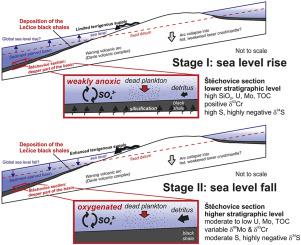当前位置:
X-MOL 学术
›
Mar. Petrol. Geol.
›
论文详情
Our official English website, www.x-mol.net, welcomes your
feedback! (Note: you will need to create a separate account there.)
Arc-related black shales as sedimentary archives of sea-level fluctuations and plate tectonics during the late Neoproterozoic: An example from the Bohemian Massif
Marine and Petroleum Geology ( IF 3.7 ) Pub Date : 2021-01-01 , DOI: 10.1016/j.marpetgeo.2020.104713 Lukáš Ackerman , Jan Pašava , Jiří Žák , Karel Žák , Václav Kachlík , Ondřej Šebek , Jakub Trubač , Martin Svojtka , František Veselovský , Ladislav Strnad , Václav Santolík
Marine and Petroleum Geology ( IF 3.7 ) Pub Date : 2021-01-01 , DOI: 10.1016/j.marpetgeo.2020.104713 Lukáš Ackerman , Jan Pašava , Jiří Žák , Karel Žák , Václav Kachlík , Ondřej Šebek , Jakub Trubač , Martin Svojtka , František Veselovský , Ladislav Strnad , Václav Santolík

|
Abstract The late Neoproterozoic Lecice black shales and an overlying siliciclastic succession, Bohemian Massif, were directly deposited in a marine environment on a volcanic arc and provide insights into palaeoenvironmental conditions at the former active margin of northern Gondwana. Field relationships integrated with major/trace element and Mo–Cr–S isotope systematics in two different sections (Stěchovice and Břežany) indicate complex depositional settings intimately connected with the waning activity of the underlying volcanic arc. The Stěchovice black shales represent a deeper part of the basin and were first deposited in weakly anoxic conditions (lower stratigraphic level) with limited terrigenous supply, as reflected by their higher total organic carbon (TOC) and U contents and positive δ53Cr, but negative δ34Spyrite values accompanied by late-stage silicification by arc-related fluids. An abrupt change to oxygenated conditions and increased terrigenous flux, characterized by lower TOC, U and Mo and coupled, negative δ53Cr and δ98Mo, is documented in the upper level of the same section. By contrast, the Břežany black shales were deposited in a shallower part of the basin and their composition (e.g., low metal contents, negative δ53Cr and δ98Mo) suggests oxygenated conditions. Furthermore, the extensive syn-to post-depositional silicification by low-temperature hydrothermal fluids was associated with Si and Ba enrichment and elevated bacterial productivity leading to higher organic matter input. The black shale deposition was terminated by arc uplift, which supplied vast amounts of terrigenous material to the basin and produced a thick flysch sequence deposited at oxygenated conditions. The estimated age of the Lecice black shales (∼580–560 Ma) suggests that their deposition may be linked to interactions between global eustatic sea level changes in response to the late Neoproterozoic glaciations (Gaskiers, Farquar) and dynamic arc topography.
中文翻译:

与弧相关的黑色页岩作为晚新元古代海平面波动和板块构造的沉积档案:以波西米亚地块为例
摘要 晚新元古代 Lecice 黑色页岩和上覆的硅质碎屑层序 Bohemian Massif 直接沉积在火山弧上的海洋环境中,并提供了对冈瓦纳北部前活动边缘的古环境条件的深入了解。与两个不同剖面(Stěchovice 和 Břežany)中的主要/微量元素和 Mo-Cr-S 同位素系统相结合的场关系表明,复杂的沉积环境与下伏火山弧活动减弱密切相关。Stěchovice 黑色页岩代表盆地的更深部分,首先沉积在陆源供应有限的弱缺氧条件下(较低地层),这反映在它们较高的总有机碳 (TOC) 和 U 含量以及正 δ53Cr 中,但δ34Spyrite 值为负,伴随着电弧相关流体的后期硅化作用。在同一剖面的上层记录了含氧条件的突然变化和陆源通量的增加,其特征是 TOC、U 和 Mo 以及耦合的负 δ53Cr 和 δ98Mo。相比之下,Břežany 黑色页岩沉积在盆地较浅的部分,它们的成分(例如,低金属含量,δ53Cr 和 δ98Mo 为负)表明含氧条件。此外,低温热液引起的广泛的沉积后硅化作用与 Si 和 Ba 的富集以及细菌生产力的提高导致更高的有机物输入有关。黑色页岩沉积被弧形抬升终止,它为盆地提供了大量陆源物质,并产生了在氧化条件下沉积的厚复理石层序。Lecice 黑色页岩的估计年龄(~580-560 Ma)表明它们的沉积可能与响应新元古代晚期冰川(Gaskiers、Farquar)和动态弧形地形的全球海平面变化之间的相互作用有关。
更新日期:2021-01-01
中文翻译:

与弧相关的黑色页岩作为晚新元古代海平面波动和板块构造的沉积档案:以波西米亚地块为例
摘要 晚新元古代 Lecice 黑色页岩和上覆的硅质碎屑层序 Bohemian Massif 直接沉积在火山弧上的海洋环境中,并提供了对冈瓦纳北部前活动边缘的古环境条件的深入了解。与两个不同剖面(Stěchovice 和 Břežany)中的主要/微量元素和 Mo-Cr-S 同位素系统相结合的场关系表明,复杂的沉积环境与下伏火山弧活动减弱密切相关。Stěchovice 黑色页岩代表盆地的更深部分,首先沉积在陆源供应有限的弱缺氧条件下(较低地层),这反映在它们较高的总有机碳 (TOC) 和 U 含量以及正 δ53Cr 中,但δ34Spyrite 值为负,伴随着电弧相关流体的后期硅化作用。在同一剖面的上层记录了含氧条件的突然变化和陆源通量的增加,其特征是 TOC、U 和 Mo 以及耦合的负 δ53Cr 和 δ98Mo。相比之下,Břežany 黑色页岩沉积在盆地较浅的部分,它们的成分(例如,低金属含量,δ53Cr 和 δ98Mo 为负)表明含氧条件。此外,低温热液引起的广泛的沉积后硅化作用与 Si 和 Ba 的富集以及细菌生产力的提高导致更高的有机物输入有关。黑色页岩沉积被弧形抬升终止,它为盆地提供了大量陆源物质,并产生了在氧化条件下沉积的厚复理石层序。Lecice 黑色页岩的估计年龄(~580-560 Ma)表明它们的沉积可能与响应新元古代晚期冰川(Gaskiers、Farquar)和动态弧形地形的全球海平面变化之间的相互作用有关。











































 京公网安备 11010802027423号
京公网安备 11010802027423号